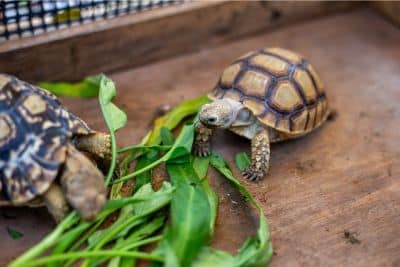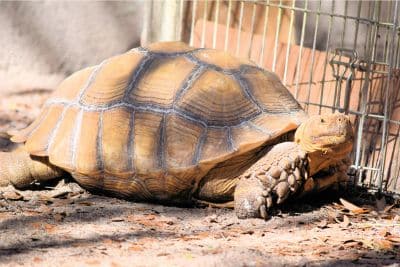Substrate selection is a pretty important consideration for tortoise keepers. After all, your animal will spend almost all of his time walking and sleeping on it – he’ll likely even burrow down into the substrate from time to time. So, it is obviously important to make a good choice that matches your preferences and your pet’s needs.
But you can’t just dump some substrate into your pet’s enclosure and consider your job finished in this respect. You also have to clean, maintain, and replace the substrate periodically.
Most conscientious keepers understand the importance of cleaning and maintaining the substrate, so they set aside the time to do these things as necessary. But unfortunately, many keepers fail to conduct complete substrate replacements on an appropriate schedule – often because they don’t understand how frequently they should do so.
That’s why I’m here to explain how often you’ll need to replace your pet’s substrate, as well as some of the important things to consider when devising a proper schedule.
The Purpose of Substrate
There are scads of different substrates that’ll work for many pet reptiles, such as snakes and lizards. But there are only a handful of options that tend to work well for most tortoises.
Soil, soil-sand mixes, coconut fibers, and cypress mulch are all good choices, as are natural ground covers like grass or clover for those who maintain their pet outdoors. Any of these will likely work well for your pet, despite the fact that they all present different strengths and weaknesses.
But no matter which type of substrate you select, it will serve several important purposes for your pet:
- Fluid absorption. You don’t want standing water or puddles of fluid spilled from the water dish to sit on the floor of your pet’s enclosure (except for the water dish, which you must regularly clean and refill). Standing puddles will lead to the growth of bacteria and fungi, but most substrates will absorb these fluids and reduce the rate at which harmful organisms grow.
- Comfortable walking surface. You want your pet to have a comfortable walking surface, just as he’d enjoy in the wild. Soils, mulches, natural grass, and other commonly used options all provide this. This is part of the reason that newspaper isn’t an ideal substrate for long-term tortoise maintenance (though it is useful during quarantine periods).
- Helps maintain humidity. While some tortoises hail from arid lands, others are native to rainforests and other high-humidity habitats. Substrates that absorb water and then slowly release it into the air (such as most mulches and soils) are invaluable in providing a high enclosure humidity level.
- Burrowing or hiding opportunities. Many tortoise species construct burrows in the wild, so it is important to give them the chance to do so in captivity (and even tortoises who don’t construct burrows will often dig down far enough to hide). Soils and soil mixes generally work best in this respect, but you may be able to compress coconut fiber enough to support burrow formation.
- Helps combat odors. Unfortunately, tortoise enclosures – even when they’re kept meticulously clean – can develop odors. But many substrates (particularly cypress mulch) have a pleasant odor, which helps prevent your pet’s enclosure from making your house smell bad.
Once you understand the role substrate plays in tortoise husbandry, you can better understand how often you’ll need to replace it.
Replacing Old Substrate
Many beginning tortoise keepers don’t realize that their pet’s substrate requires periodic replacement. After all, they regularly remove feces, shed scutes, and uneaten food – it should be clean, right?
Unfortunately, the answer is no.
Despite regularly spot cleaning the substrate, it will still become dirty over time. This is partly due to the fact that some portion of your pet’s waste (especially the fluids expelled with it) will seep down into the deeper levels of the substrate. The same can be said for small bits of food. Additionally, the moisture present in the substrate will also help foster the growth of bacteria and fungi.
It’s also important to note that some substrates will tend to break down over time.
The individual pieces of cypress mulch, for example, will break and splinter with time. If you leave cypress mulch in the enclosure long enough, it’ll essentially become soil-like in consistency. This isn’t necessarily a problem, but if you wanted a substrate that was soil-like, you’d probably just start with soil in the first place.
All of these factors mean that no matter how well you clean your pet’s substrate, you’ll need to replace it completely from time to time.
When to Replace
Part of the reason many keepers fail to replace their substrate frequently enough is that there aren’t many clear-cut rules about the frequency with which substrates require replacement. To an extent, you simply have to use your best judgement.
Some of the things you want to consider when deciding how often to replace the substrate in your tortoise’s enclosure include:
- The type of substrate you’re using: Some substrates require more frequent replacement than others. For example, soil and sand will not break down very much, while cypress mulch will. The more quickly the substrate breaks down, the more quickly you’ll have to replace it.
- Moisture levels in the substrate: Generally speaking, the damper the substrate, the more rapidly microorganisms will proliferate. This means that damper substrates require more frequent replacement than drier substrates.
- How many tortoises are in the enclosure: It is very important to conduct regular substrate changes in habitats featuring multiple tortoises. The substrate in enclosures housing multiple tortoises will require much more frequent replacement than the substrate in an enclosure housing only a single animal.
- Size of the enclosure: As a general rule, the larger the enclosure, the less frequently you’ll have to replace the substrate. This is because the larger volume of substrate essentially “dilutes” the waste, bacteria, and other contaminants present.
- Cost of the substrate: Although tortoise keepers should always keep their tortoise’s well-being at the forefront, costs are a factor in the real world. That doesn’t mean you shouldn’t replace an expensive substrate regularly, but it does mean that you may want to consider replacing affordable substrates more frequently.
- Substrate manufacturer’s recommendations: While you’re unlikely to find a manufacturer’s recommendation relating to tortoise husbandry on a bag of organic potting soil, some commercial reptile substrates (especially cypress mulches and coconut fibers) will come with replacement frequency guidelines.
As you can see, there are a number of things you’ll want to consider when deciding on an appropriate substrate replacement schedule. However, most keepers will find that monthly or bi-monthly substrate replacement works well for small enclosures (those with less than 8 to 10 square feet of space).
For larger enclosures, it will generally be acceptable to replace the substrate one to four times per year (such as the beginning of each new season).
An Important Exception: Natural, Outdoor Ground Covers
If you keep your tortoise outdoors and rely on grass, clover, weeds, or some other type of substrate, you’ll face some unique challenges.
For starters, it isn’t often realistic to completely remove and replace the existing substrate – it’d not only be exceptionally expensive to do so, but it would take quite a bit of time and effort. And you’d likely have to figure out somewhere else to keep your pet while you carried out the process.
Accordingly, keepers who maintain this approach must be incredibly vigilant about cleaning up after their pet. You’ll want to clean the environment every day and consider replacing small portions of the substrate (such as a square foot or two) if they become exceptionally dirty.
Fortunately, there are a few natural processes that will help prevent pathogens from building up in outdoor enclosures with natural ground covers. For example, strong sunlight is often detrimental to bacteria and other harmful microorganisms. Additionally, there will be a number of beneficial insects and microorganisms in the soil, which will help break down waste and compete with harmful bacteria.
Citations
- Star Tortoise Garden – Substrates
- Pet Helpful – Substrates and Safe-to-Use Plants for Tortoise Enclosures
- Tortoise Trust — Understanding Vivarium Substrates


